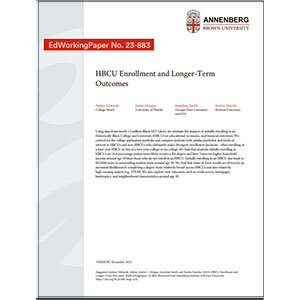HBCU Enrollment and Longer-Term Outcomes

Students who enroll in historically Black colleges and universities (HBCUs) initially are 14.6 percent more likely to attain a BA degree and, by around age 30, report a 5 percent higher household income compared to their counterparts who do not enroll in an HBCU, according to the report HBCU Enrollment and Longer-Term Outcomes (56 pages, PDF) from the Annenberg Institute at Brown University. The report is based on data from nearly 1.2 million Black SAT takers and estimates the impacts of initially enrolling in an HBCU on educational, economic, and financial outcomes. According to the report, nearly 40 percent of Black students apply to at least one HBCU, and 10 percent of all Black college students enroll in HBCUs. The report further highlights the outsized role in society and the economy HBCUs play by noting that 50 percent of Black lawyers, 80 percent of Black judges, 40 percent of Black engineers, 40 percent of Black Congressmembers, 50 percent of Black teachers at public schools, and 50 percent of Black faculty at predominantly white research universities are HBCU graduates. In conclusion, the report found that HBCUs offer a valuable pathway for Black students in the United States. However, the findings also reveal an average of $12,000 more in outstanding student loans by age 30 and a slightly lower probability of owning a mortgage. According to the report, the results should be interpreted in the context of under-resourced HBCUs, which, in comparison to their peer institutions, report greater reliance on student loans, potentially limiting the positive impact they could have on Black individuals and the American economy. Despite challenges such as inadequate funding and legislative scrutiny, HBCUs continue to play a vital role in providing access to Black students and supplying talented graduates to the American workforce in the 21st century.




